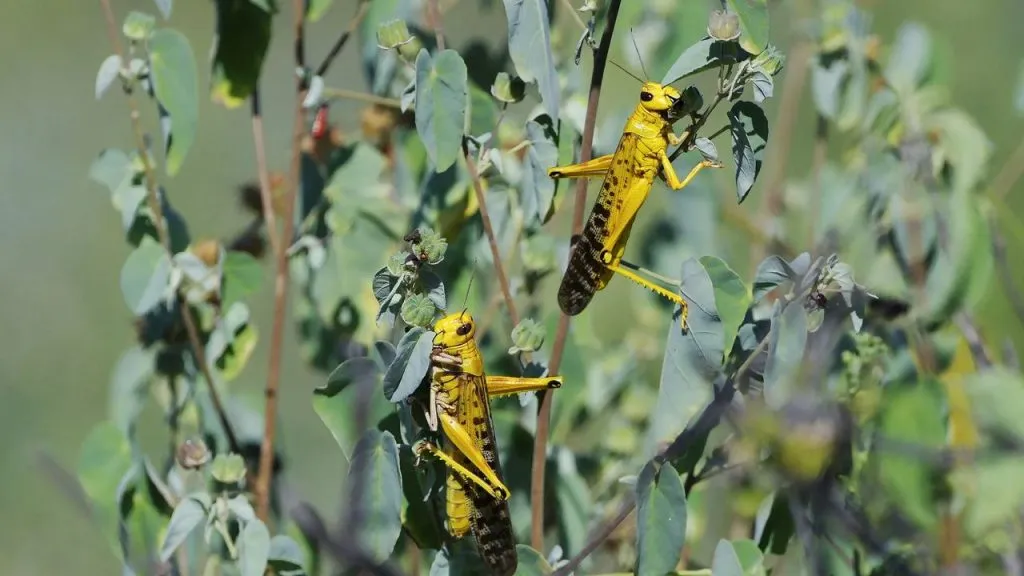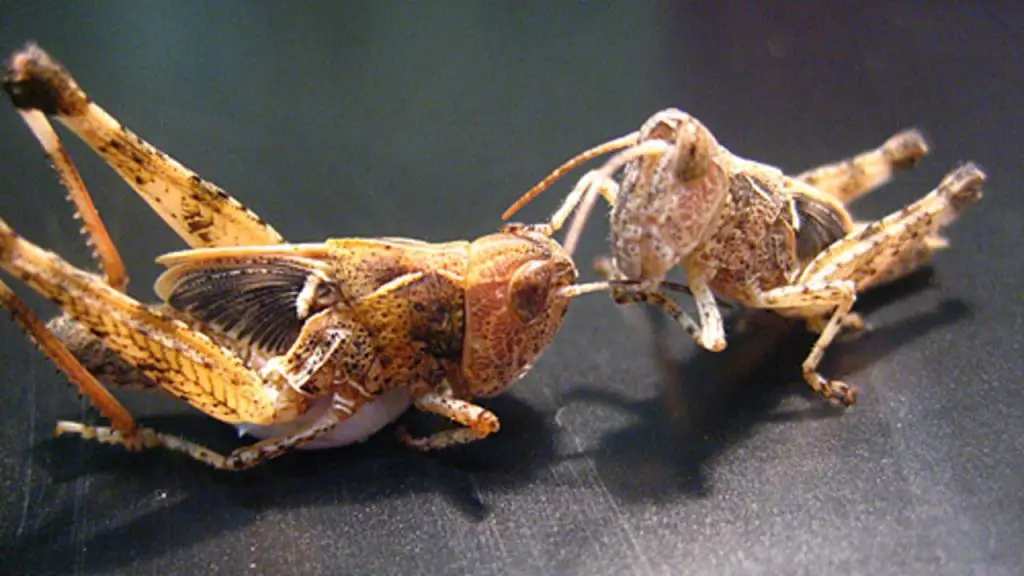As an Amazon Associate I earn from qualifying purchases.
Locusts are a type of grasshopper that have short horns and belong to the Acrididae family.
They can be damaging to an economy because of how they live.
Sometimes, they’re solitary and don’t cause much trouble.
But other times, they come together in huge groups and wreck crops, especially in agriculture.
Locusts have been fascinating and puzzling insects for ages.
One of the questions people often ask about these creatures is, “What do locusts like to eat?
Figuring out what they like to eat isn’t just important for science, but also for managing agriculture and dealing with pests.
In this guide, we’ll explore what different kinds of locusts eat, how they eat, and how they find food. Let’s dive in and learn more!
What Do Locusts Eat Throughout The Year: The Complete List of Food

Locusts, those plant-eating bugs, have a diverse diet that varies depending on factors like their species, age, and food availability.
They mainly munch on tender leaves from various plants, including trees and bushes, especially favoring young leaves.
Grass, whether it’s wild or cultivated by farmers, is also a favorite, along with many other green plants.
While they’re not particularly picky and will nibble on fruits, veggies, and seeds, plants make up the bulk of their diet.
When they’re really hungry, they might even chew on tree bark.
Although their primary diet consists of plants, locusts might resort to eating other insects, including their kind, if they can’t find enough plant-based food.
Here’s a detailed list of what they eat:
- Grasses: Sorghum, Wheat, Corn, Millet, Oats, Barley
- Leaves: Lettuce, Spinach, Cabbage, Kale
- Fruits: Apples, Pears, Grapes, Bananas
- Vegetables: Carrots, Potatoes, Tomatoes, Peppers
- Shrubs and Trees: Acacia, Mimosa, Date palm
Locusts change what they eat depending on things like their type, how old they are, and what food is around.
This helps them survive and cope with different environmental changes throughout the year.
What Do Desert Locusts Eat?
These locusts are notorious for gathering in huge groups that wreck farmland in Africa, the Middle East, and Southwest Asia.
Desert locusts mostly munch on green plants like leaves, grasses, flowers, buds, and soft stems.
They’re not picky, though, and will gobble up crops like millet, sorghum, barley, wheat, and various grasses, causing big problems for farmers.
These insects can eat a lot every day, sometimes as much as their weight, which can be a serious threat to food supplies because they can wipe out fields in no time.
What Do Carolina Locusts Eat?
Carolina Locusts, also called Dissosteira Carolina in science, are bugs native to North America.
You can find them in grasslands, open areas, and farmlands across the eastern United States.
They like to munch on grasses, leaves, and flowers from different plants, especially broad-leaved ones like dandelions, milkweed, and sunflowers.
While they don’t wreck crops as much as some other locusts, they still eat plants in fields and open areas.
These locusts are pretty good at adjusting their diet to whatever food is around, and they don’t move around as much as desert locusts do.
What Do Migratory Locusts Eat?
Migratory locusts are bugs that travel far and cause big problems for crops.
They eat a mix of leaves, shoots, flowers, fruits, seeds, and stems from different plants, similar to desert locusts.
When they swarm, they eat up a lot of plants as they move around, which makes life hard for farmers and agriculture.
What Do Green Garden Locusts Eat?
Green garden locusts, part of the same species as migratory locusts, have a diverse diet that includes leaves, flowers, and fruits from many plants.
They especially like legumes, veggies, and fruit trees. You can also spot them munching on different plants in gardens and farms.
These locusts are originally from Africa and can cause significant damage to various crops, making them troublesome pests.
What Do Baby Locusts Eat?
Baby locusts, also called nymphs, like to eat the same kinds of plants as grown-up locusts, but they prefer smaller and softer ones.
They mostly munch on green plants like leaves, grasses, shoots, and soft stems.
These little locusts eat a lot because they’re growing quickly and need a bunch of nutrients.
They go for young and tender plants that are easy to chew and digest.
As they get bigger, they eat even more and keep munching on green plants, just like adult locusts, but they stick to the smaller and more delicate parts of the plants.
What Do Locusts Eat in Captivity?
In captivity, locusts are fed food that’s like what they eat in the wild.
They get fresh green plants like grass, clover, lettuce, and kale.
Sometimes, they also get veggies and fruits like carrots, cucumbers, apples, and oranges to make sure they’re getting all the right nutrients they need.
It’s important to always have water available for them, preferably in gel pads or soaked cotton wool to avoid accidents.
Some locusts in captivity might also eat cricket food or commercial diets made just for locusts that you can buy in stores.
These diets have a mix of plant stuff, proteins, vitamins, and minerals to keep the locusts healthy and happy.
Taking good care of locusts in captivity means giving them a variety of healthy food to eat so they stay healthy, reproduce if needed, and can be used for research or learning purposes.
It’s all about making sure they have what they need based on what they eat naturally.
How Do Locusts Find Its Food: The Hunting Method of Locust

Locusts don’t go out looking for food like predators do. Instead, they use their senses to find plants to eat.
Their big eyes help them see movement and changes in light, so they can spot potential food from far away.
Locusts also have a good sense of smell, which helps them find plants by detecting their scent.
When they find a plant, they use their taste buds to check if it’s good to eat and safe.
Sometimes they also feel the texture of the plant to see if it’s tender and easy to eat.
Things like temperature, humidity, and how many plants there are around also affect where they look for food.
Overall, locusts rely on their senses of sight, smell, taste, and touch to find food and grow big and strong.
Conclusion
In summary, locusts are flexible eaters that like different foods depending on their type and where they live.
Some kinds of locusts can cause big problems for farmers when they swarm, but others are important for keeping ecosystems balanced by eating plants.
Knowing what locusts like to eat and how they behave when they eat is crucial for finding good ways to control them and protect crops and nature.
FAQ’s:
Locusts are found in various habitats around the world, including grasslands, agricultural fields, open landscapes, and sometimes even urban areas.
They prefer warm climates with plenty of vegetation to feed on.
Locusts themselves are not harmful to humans, but their swarms can cause significant damage to crops and agricultural fields, leading to food shortages and economic losses in affected areas.
However, locusts are not poisonous or venomous to humans.
Locusts do not typically bite humans, as they are herbivorous insects that primarily feed on plants.
In the rare event of a locust bite, the affected area should be cleaned with soap and water to prevent infection.
If there are any signs of allergic reactions or severe symptoms, medical attention should be sought immediately.
The lifespan of a locust varies depending on factors such as species, environmental conditions, and life stage.
Generally, the lifespan of a locust ranges from a few weeks to several months.
Some species may have shorter lifespans, while others can live longer, especially in favorable conditions with abundant food and suitable habitat.
Amazon and the Amazon logo are trademarks of Amazon.com, Inc, or its affiliates.

